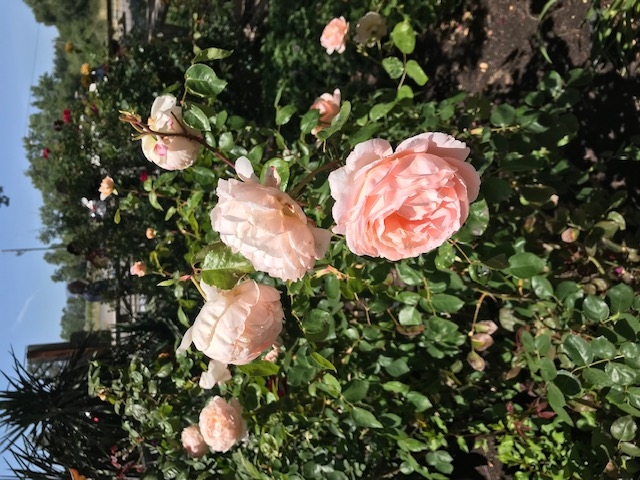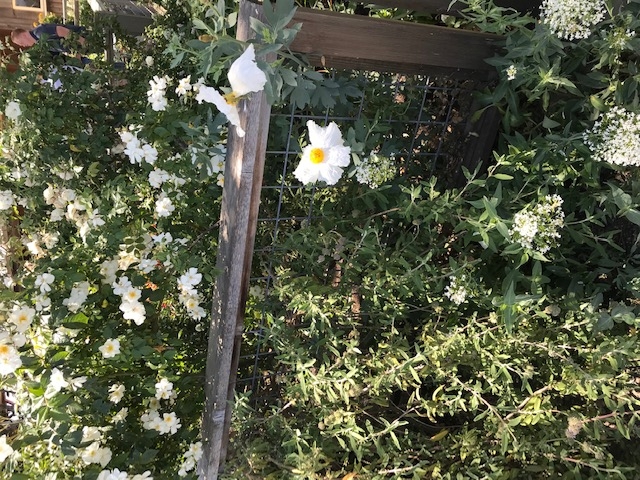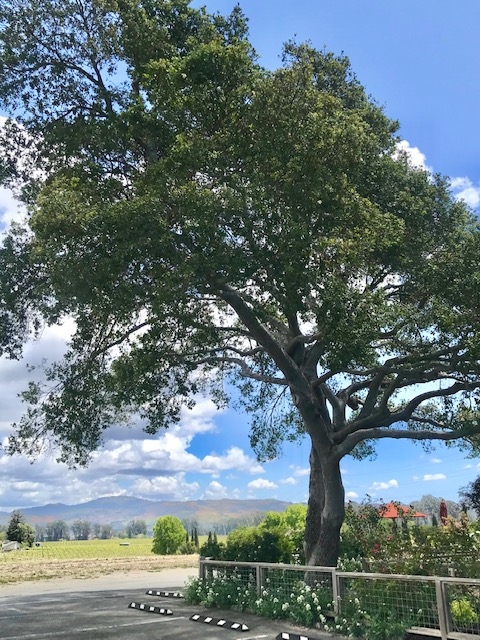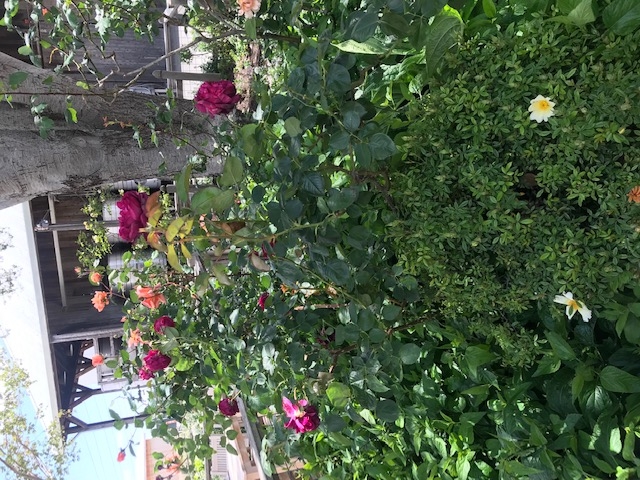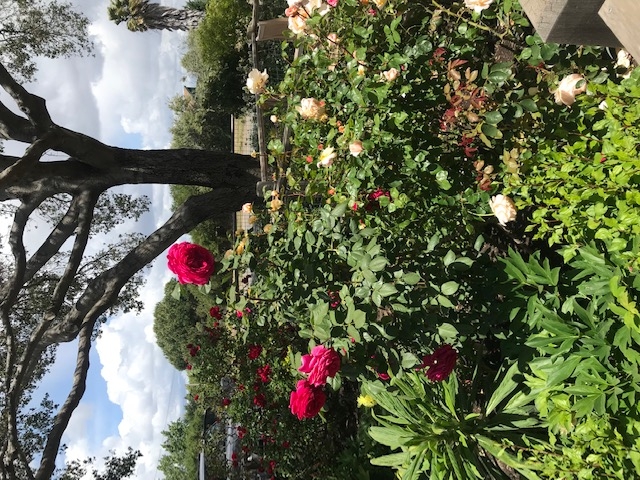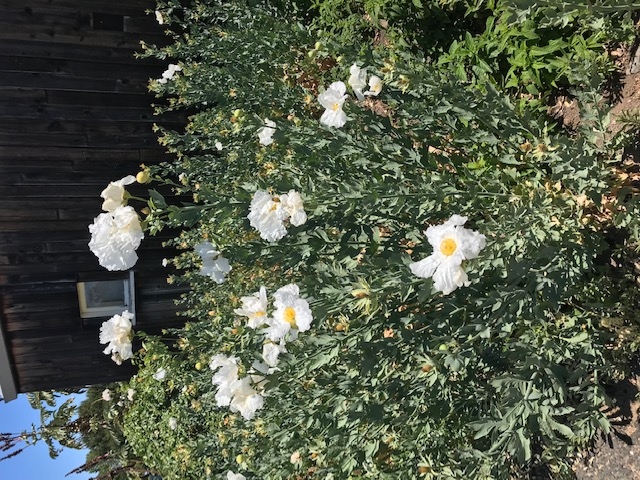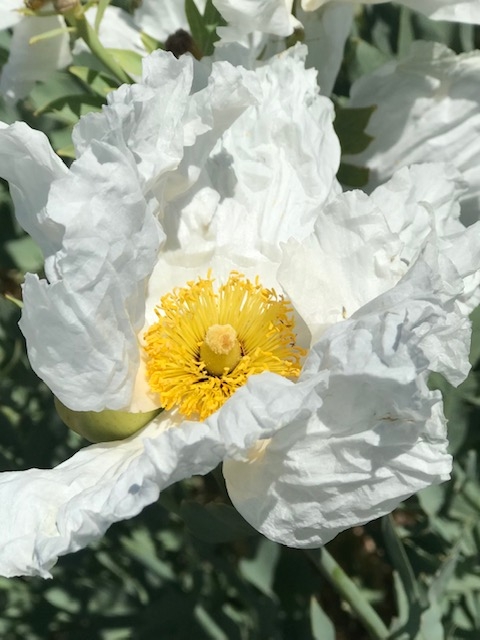One of my neighbors, David Graves, is a partner in the Carneros winery Saintsbury. It's a small but thriving enterprise and very attractive because of its garden, making it a pleasant place to sit and enjoy the flowers and the bees, butterflies and hummingbirds attracted to them. I have watched the garden's evolution over 30 years.
Recently I talked to David about how the garden developed and how its caretaker keeps it looking nice--especially this time of year, when everyone's yard looks a bit worn.
Graves began the winery and the garden with his business partner, Dick Ward, more than forty years ago. The first thing they did was plant California native oak acorns. They obtained the acorns from neighbor Lee Hudson's Carneros ranch. The oaks (Quercus agrifolia) have flourished, and their acorns have been planted by scrub jays all over the area. (People complain about scrub jays, but Graves likes them.)
The initial garden had a lawn "and all sorts of inappropriate things," says Graves, but then the partners decided to get serious about the landscape. They hired Michael Bates, a garden specialist from Sonoma.
The garden had to be reconstructed from the bottom up. There was no topsoil on the site, and it had terrible drainage due to a faulty storm drain. Plants drowned when it rained.
Bates dug down two feet and amended the soil with blood meal, bone meal and gypsum. Graves insisted on using compost from grape waste, so Bates told him to add no more than 30 percent.
"David went behind my back and put in 50 percent, and it was successful, so I use it all the time now," says Bates. The compost keeps the soil from compacting, and today the soil is healthy and fertile.
Most afternoons Carneros experiences a stiff breeze from San Pablo Bay, but the winery building shelters the garden. Even so, Bates says that the site is the most difficult one he has ever tackled. The large native oaks shade many areas, creating a challenge for some plants.
The garden features David Austin roses—a nod to Bates's English heritage—as well as a mix of Mediterranean and California native plants. In late spring, visitors see a spectacular display of Matilija poppies (Romneya coulteri) on the office building's sunny south side. I have had no luck with that show-stopping native, but the poppies are obviously happy there. They reseed and are prolific in spring.
To balance the native oak on the left, Bates likes to have a few "statement plants," as he calls them, on the right. One tall, showy, almost science fiction-like plant is echium (Echium wildpreti). It reminds me of a Gaudi church tower—a decorative spire. Bates calls it a "tower of flowers."
Another statement plant is the tree dahlia (Dahlia imperialis), a native of Mexico, here commingled with a hybrid musk rose. Bates also put in meleanthus (Meleanthus major) and it took off. Meleanthus is an evergreen shrub with a brilliant red tassel-like flower on top. “It's the only one I have ever planted,” says the landscaper. “It makes quite a statuesque plant."
Bates allows plants to express themselves. When other people prune madly, he sometimes just leaves a plant alone. At Saintsbury, you often see plants at different stages of growth: sprouting, blooming, forming seed pods, and so forth.
Bates also planted lots of salvia and easy-care Iceberg landscape roses. The beds are edged with blue catmint (Nepeta) and include a lot of white valerian—an impossibly healthy plant that reseeds lavishly and has low water needs. Right now Bates is adding phlox. "It carries the garden through July and August,” he says.
One change I noticed over the years was the addition of a rail fence. Graves said that visitors needed a little behavior modification. Without the fence, they would wander in a carefree manner right through newly planted flowerbeds.
Cobblestones divide the beds from the decomposed granite paths. "Those were brought over from San Francisco when some cobbled streets were replaced with asphalt," said Graves. The fences don't confine the plants, which reseed and grow outside the boundaries. The whole effect is very loose and relaxing, which is exactly the feeling we should receive from a garden.
Most of us don't have a garden helper who shows up every couple of weeks to evaluate plants, do judicious pruning and replant when needed. However, there are some lessons in the Saintsbury landscape for the home gardener.
First, compost really works. It improves soil texture and plants' ability to access water and nutrients.
Take chances: plant something new, and if it thrives, hooray. If it doesn't, try something else.
Don't worry about mixing different types of plants. Traditional European plants go well with natives.
When you are planting flora, choose some that bees, birds and butterflies like.
Remember that water is a finite resource, so use native plants when you can. Finally, a garden can be interesting at all points in the growing cycle. Don't worry about everything being in perfect bloom simultaneously.
Become a Master Gardener Volunteer! UC Master Gardeners of Napa County is now accepting applications for the Class of 2023. Click on the ”Join Us” button at napamg.ucanr.edu to read the informational brochure and register to attend a mandatory information session for applicants. Applications are due before 5 p.m. on September 30.
Free Guided Tree Walk: Join UC Master Gardeners of Napa County for a tree walk at Fuller Park in Napa on Tuesday, August 9, from 10 am to noon. Space is limited to 12 people and each person attending must pre-register. REGISTER HERE FOR AUG 9 TREE WALK
Food Growing Forum: Join UC Master Gardeners of Napa County for a free forum on “Seed Saving” (and what else to do in the garden in August) on Sunday, August 14, from 3 pm to 4 pm, via Zoom. Register to receive the Zoom link: https://ucanr.edu/2022FoodForumAugust
Got Garden Questions? Contact our Help Desk. The team is working remotely so please submit your questions through our diagnosis form, sending any photos to mastergardeners@countyofnapa.org or leave a detailed message at 707- 253-4143. A Master Gardener will get back to you by phone or email. For more information visit https://napamg.ucanr.edu or find us on Facebook or Instagram, UC Master Gardeners of Napa County.
Attached Images:
